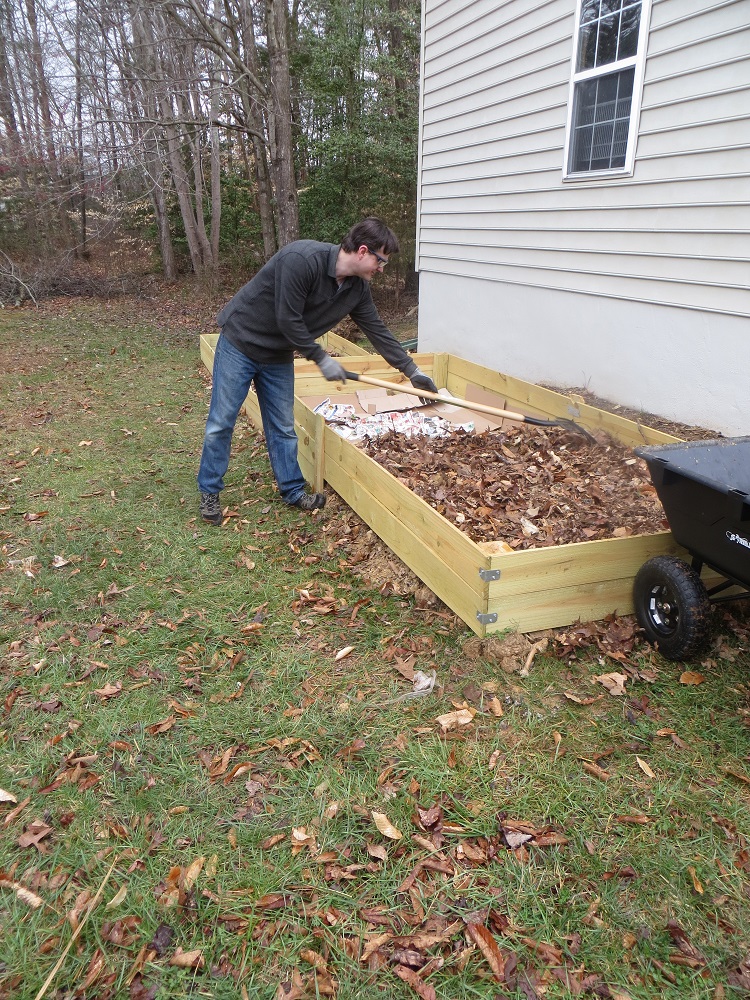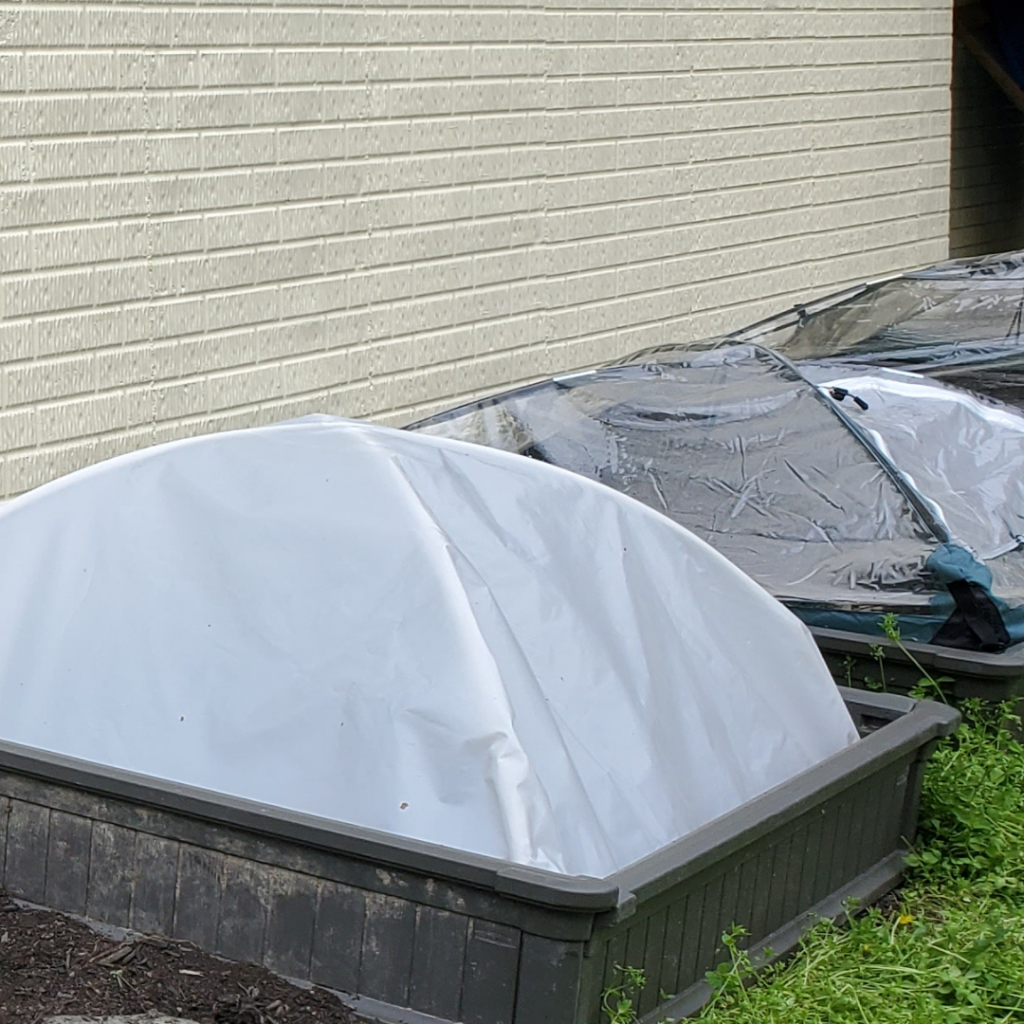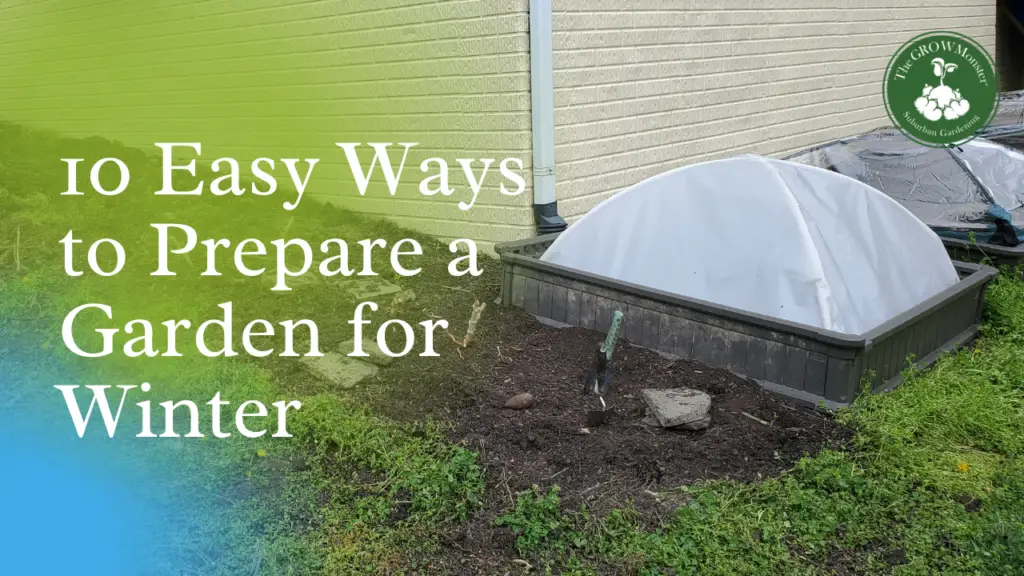Every year as the temperature drops I think about preparing our garden for winter. At The Grow Monster, we decide whether we will be planting any winter crops, where they will be located, and what we will do with the garden space left over (if any). Whether you are using your garden in the winter, and no matter what zone you are in, there will certainly be some things you need to do to prepare a garden for winter.
Follow these 1o easy ways to prepare a garden for winter. You will not only have a healthy winter garden, but also be ready when spring comes with better soil, more compost, and a plan to create your spring garden.
10 Easy Ways to Prepare a Garden for Winter:
- Plan what you are going to plant over winter, if anything.
- Clean out the previous season’s plants, debris, and containers- including perennial and bulb care.
- Does my garden area need any repairs or replacing?
- Get garden areas ready to winter sow.
- Winterize garden areas without plants.
- Maintain your compost pile.
- Create a timeline for harvesting.
- Build supports and protection for your winter garden.
- Assess how well your previous garden did.
- Plan your spring garden.
Plan What To Plant in A Winter Garden
The first thing I do to prepare a winter garden is to determine whether I would like to grow anything in The Grow Monster garden over the winter. If you don’t already know, you want to first check what zone you are located in to determine what plants will even grow in your winter temperatures. You can check out the USDA website here and input your zip code to find your zone or look on the map below.
Then, make a list of what plants will work in your zone. If you are planting in a greenhouse, using some sort of row covers, or a hoop house then take that in to consideration when choosing your plants. You can usually look on the seed packet or plant information online to determine what temperatures, zones, and climates a plant will tolerate. One thing to note is studies show that plants in containers will need to be considered 2 zones colder than what your zone usually is.

An example for a winter garden is to choose mostly leafy vegetables or root vegetables. I’m located in plant hardiness zone 7A so we like to have areas with carrots, kale, and swiss chard. These plants also tend to taste less bitter and more sweet when grown and harvested in the winter. One benefit of planting root crops in your winter garden is that they will also help aerate your soil.
Clean Out the Previous Season’s Plants, Debris, and Containers- Including Perennial and Bulb Care
Clean any garden spaces that still have old plants, harvest any last minute produce, remove plant supports and structures, and clean out any containers you might have. At The Grow Monster, this means we start to add a lot of plant matter to our compost pile. What I like to do is get everything in one large pile with plants, stems, any rotting fruits and vegetables separate from the compost pile. Then, we are able to take the lawn mower to break all those plant components down to be much more manageable in our suburban garden compost pile. You don’t want a huge heap bothering the neighbors!

Depending on what perennial plants you have you may need to do some pruning, cutting back, or even removal if the plant is not doing well. This is a great time to take a look at what perennials may have spread out and can be transplanted, traded, or given away to others. You will also need to take care of your bulb plants either dividing and replanting, giving away, or trading any extras. It will also be time to replant any bulbs that you have removed or bought that will flower in the spring like Daffodils and Tulips. Just make sure that the soil has cooled off enough for your zone.
Does My Garden Area Need Any Repairs or Replacing?
When you are cleaning out your garden spaces it’s a great time to check any raised beds, containers, trellises, and structures to determine if there is any damage to repair or anything needs to be replaced. Make sure to check all wood items because it’s better to fix them now while there is nothing in the garden compared to when you are full swing and a piece of wood completely gives way. Also, check any plastic items for breaks and cracks. Some containers may need to be brought inside the garage, shed, or home to protect them through the winter.

Take time to actually disassemble your trellises and supports to check that everything is in working order for next season’s garden. Nothing gets you off your garden timeline then dragging out a half-broken plant support that should have been replaced at the end of last season. Another benefit of fixing or replacing broken garden items while you prepare a garden for winter is many stores will have those items on clearance right now. Even the prices on Amazon come down as we move in to the winter gardening season. Use this link to check current pricing on garden trellises and supports at Amazon.
Get Garden Areas Ready to Winter Sow
For the garden areas where you will be planting over winter, get the soil ready to plant. Think of whether you will be planting starts or directly sowing seed. If you are directly sowing seed, then make sure you correctly space your seeds and put a few in to account for lower germination rates. At The Grow Monster, we usually use the Square Foot Gardening method of seed spacing but you could plant however your garden space produces most efficiently for you. If you are planning to start your seeds earlier and then transplant, check out this post where we show a step-by-step guide to germinate seeds quickly and easily.
Before you put in your seeds or transplants add compost to your soil. You want to take the compost that has already aged from your compost pile or purchase some to add nutrients back to the soil. Mix it in well and top off with mulch to help maintain moisture and insulate the ground while your plants grow. Next, you want to either plant your seeds or transplant your starts. Make sure if you are planting seeds to leave spaces without mulch for the buds to get through. Once the seeds have germinated and popped above the ground then you can move the mulch around the plant.
Winterize Garden Areas Without Plants
An important task to prepare a garden for winter is make sure to winterize the garden areas without plants. Don’t skip this step! You will thank yourself in the spring if you take the time to do these easy tasks as you move in to winter. You will need to cover your winter garden. What this looks like can vary depending on where you live and what your zone is. There may be perennials you need to cover with a hoop house, cliche, or even dig them up to bring in over the winter.
There are many options to cover your winter garden. Some people like to cover their entire garden in cardboard- make sure to remove any labels, staples, or tape that might be on boxes you use. The cardboard will help cover any weed seeds to make sure they do not germinate in the spring and will also breakdown to help feed your soil. Another option is to cover your garden area with plastic. The darker the plastic the better because it will block out the sun and stop any weed seeds from germinating. Lastly, you can choose to cover your garden in leaves that will break down over winter and help to feed your soil for the spring.

Maintain Your Compost Pile
When you are actively gardening, you generate a lot to add to your compost pile. Some people don’t realize the best way to prepare a garden for winter includes maintaining your compost pile. There are various ways to contain your compost; you can read The Grow Monster article here about 7 different ways to compost to decide which might be best for you. We currently have a big pile we maintain in our backyard.
The first thing you need to do is make sure you turn your compost every so often, what better time then when you are switching seasons to prepare a garden for winter! Take all the compost you have been making over the last season and turn it well, making sure to remove any larger pieces of wood or stems that didn’t fully decompose yet. Then, spread that compost over your existing garden beds even if you aren’t planting anything there until spring. This is also a good time to decide if you might want to change up the way you compost for next season. Maybe try a different method or experiment to compare methods.

Once you have cleared out all the usable compost, it is time to get your new compost pile started. Take all the plants you removed from your garden while cleaning up the beds and make a shorter pile with them and run the lawn mower over it a couple of times. This helps break it down so it will take less time overall to compost. The goal is to have this new pile be ready to use in your spring garden beds. Make sure you mix in a little water when you start piling it up again. Then, just let it do it’s thing over winter and in the spring you will have nice compost to use in the garden.
Create a Timeline for Harvesting
Now that you’ve got your garden beds cleaned and planted new plants you need to set a timeline for harvesting. If you haven’t planted anything in your winter garden, then you can just skip this step. Take a look at the seed packet and plant information for each plant you have in your winter garden. See what the timelines is to harvest for each crop. An important part to prepare a garden for winter is to make sure that you are able to harvest and enjoy your produce. You don’t want to realize too late that you should have already harvested your plants or they may already gone to seed.
At The Grow Monster, we also keep a garden journal so we can see about when we were harvesting or pulling plants in years past. Also note temperature patterns from year to year in case some plants in your winter garden need to be covered in more severe freezes or winter storms. If plants need protection during the winter, this is a great time to plan out how you will water them while they are under cover. During the winter it can still get dry and plants will then need to either be watered with a hose or container or you can install some sort of irrigation system.
Build Supports and Protection for the Winter Garden
Some plants require supports like trellises or cages and some might need to be covered to grow well in the winter garden. When you prepare a garden for winter, you have to include these things for those plants that need them. Depending what zone you are, you might be able to grow pole beans or snap peas during the winter and they will need some sort of trellis to keep them off the ground. Plants that require trellising won’t do as well if you allow them to lay on the ground. They can become diseased or more easily accessed by pests looking for a winter food source.
When you were cleaning up your garden spaces you should have collected all of the trellises, cages, and plant coverings. Now that you have them all in one location it will be easier to see what you have and what additional items you may need to build or purchase. They should be in working order since you have already noted what needed repair or replacement from our previous step. Now, just place them around your plants. If you have planted leafy greens that will not tolerate your lowest temperatures then be ready to cover them when needed. Have your covering system set up for plants that need hoop houses or covering at night as well.

Assess How Well Your Previous Garden Did
Now that you have cleaned up your garden spaces, put items away, cleaned, repaired, replaced, and replanted it’s time to take a break and reflect on the previous season’s garden. How well did your garden produce? This is a great time to look back over your garden journal and even compare this past season to prior year gardens. Was there a certain pest that you hadn’t encountered before? Did you try your beans in a different area and it didn’t work as well? Maybe you added flowers to attract more pollinators and had a bumper crop of cucumbers?
Plan Your Spring Garden
While you have your garden journal out, start planning your spring garden. Since you’ve already assessed how well you did and compared that with previous years you should have an idea of what you want to try again next year or change. Write those ideas down while they are fresh in your mind, otherwise it will be too easy to forget your thoughts.
Make a list of seeds you will need to purchase. Decide what you might want to purchase as starts. Maybe you want to try something new and need to learn more about how to grow it. This is a great time to jot down some notes on what plants you may need to research to be better prepared next time. It’s also a great time to make a list of any new tools you may plan to purchase for your garden. When someone asks what you might like for Christmas, you can just pull up the list to give them.

Final Thoughts
Whether you are choosing to grow a winter garden or just need to clean up after the season is over, there are a few things you can do to ensure you are being efficient to prepare a garden for winter. You will want to plan, clean, put away, repair, replace, plant, and, assess your garden. You will have a healthy winter garden, better soil, more compost, and best of all relax. Maybe you haven’t been keeping a garden journal? Now is a great time to start to remind yourself from year to year and season to season about all of your gardening experiences.
If you’ve liked reading this article, check out our post on the different ways to compost here so you can build better soil for your garden.



Pingback: Is It Too Late to Plant Tulips: 3 Expert Tips for Planting! - The Grow Monster